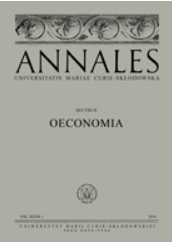Economic Activity of Residents and Revenue Autonomy of Municipalities in the Context of the COVID-19 Pandemic
Economic Activity of Residents and Revenue Autonomy of Municipalities in the Context of the COVID-19 Pandemic
Author(s): Andrzej Sobczyk, Daniel BudzeńSubject(s): Economy, National Economy, Public Finances
Published by: Wydawnictwo Naukowe Uniwersytetu Marii Curie-Sklodowskiej
Keywords: economic activity; development potential; own revenue; financial autonomy
Summary/Abstract: Theoretical background: The impact of the COVID-19 pandemic has had far reaching effects on different strata of socio-economic life, including the financial well-being of residents and the financial situation of local government units. Generally, research papers either approach “local development” conceptually or quantify data regarding a certain locality: demographic structure, residents’ education, condition of the labour market, residents’ income and their technological literacy. This paper is an attempt to arrive at a larger picture and identify the interdependence between economic activity of residents and financial autonomy of the local government, and secondly, to pinpoint the impact the COVID-19 pandemic had on these categories.Purpose of the article: The purpose of the paper is to identify residents’ income sources and the dependence between them and the development potential of the municipality they live in. The paper examines residents’ revenue, income and income tax advance payments. The survey covers all municipalities in Poland according to their formal administrative status: urban, rural, urban-rural and cities with powiat rights. The research covers the period of 2015–2020, as per data availability.Research methods: The paper applied monograph methodology to review the literature on the subject, and comparative methodology to process quantitative data, which allowed the authors to calculate all deviations. Next, the economic phenomena were assessed, i.e. their nature (positive or negative) and frequency of occurrence were determined according to an assessment scale where the base is the starting point. The structure of the number of taxpayers, their revenues and incomes was compared by sources of income, in result of which hierarchy of income sources was created for each municipality. Following that, the main income sources were analysed and correlated with the municipality’s own (tax) revenue. To enable comparability of diagnostic variables, the zero unitarisation method was applied.Main findings: The findings reveal that the main sources of residents’ income include salaries, pensions and disability pensions, non-agricultural economic activity, wages and contractual income. Revenue streams generated from residents’ economic activity show a variance across municipalities. The results obtained confirm the dependence between residents’ economic activity and own revenue sources of local government units. Based on the findings, it can be concluded that the relationship between taxpayers’ income from particular sources and revenue autonomy of municipalities and cities with powiat rights varies by the type of municipality. Thus, the findings clearly demonstrate that residents’ economic activity is an endogenous resource that definitely affects municipal development. For local authorities, understanding economic realities of residents may be a game changer and an insight that will help them create environments conducive to socioeconomic growth.
Journal: Annales Universitatis Mariae Curie-Skłodowska, Sectio H Oeconomia
- Issue Year: LVI/2022
- Issue No: 3
- Page Range: 127-147
- Page Count: 21
- Language: English

